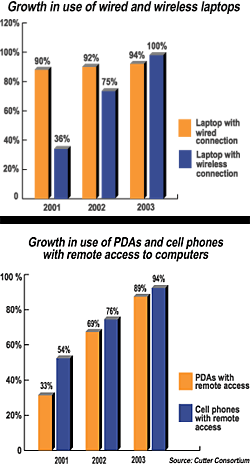Waiting for Wireless

Cell-phone users revel in mobility: the freedom from the traditional hindrance of wires and wall-mounted jacks. Computer users should expect the same ... sooner than later, according to knowledgeable insiders.
Cell-phone users revel in mobility: the freedom from the traditional hindrance of wires and wall-mounted jacks. Computer users should expect the same ... sooner than later, according to knowledgeable insiders. While universal wireless computing is not quite ready for prime time, evolving standards and technological innovation are pushing adoption, particularly in critical areas such as national defense, law enforcement and medical care, where mobile management of information offers unprecedented efficiencies. "Interest is very high. Deployments and implementation are accelerating," said Ken Whitehead, director of federal operations for software integrator Aether Systems Inc. of Owings Mills, Md. "When you consider the cost of a [wireless] hand-held vs. the cost of a laptop, it provides a very high return on investment. It's a great replacement for a paper and pencil."Not all small computers are created equal, however. New generations of wireless devices have little trouble with transmission of garden-variety text, especially in bite-size bursts. Nonetheless, even though protocols are under development and evaluation, wireless at present cannot routinely or easily handle large amounts of graphics-rich information. High-bandwidth, hard-wired networks continue to provide that capability with thus-far unmatched rates of data exchange. Wireless computing also faces security issues above and beyond those confronted by wired systems. Absent robust encryption, would-be data thieves can snatch information literally out of thin air. In-person intrusion isn't necessary when wireless radio transmissions can be monitored and captured from a nearby park bench or parking lot using inexpensive, off-the-shelf devices. Despite these concerns ? and many believe such problems are, at least in the long run, tractable ? wireless remains an area of keen interest to decision-makers both in and out of government. A report published last year by Federal Sources Inc., a McLean, Va., firm that specializes in public-sector, information technology market research, estimated that wireless implementation within the federal government should more than quadruple from $1 billion in 2000 to $4.3 billion through fiscal 2004.Estimates seen by hand-held manufacturer Palm Inc. of Santa Clara, Calif., indicate that the percentage of wireless computing users worldwide will swell from 3 percent in 2000 to more than 60 percent by the end of 2003."Today, it's difficult to access and process Web-based information. But downstream, when we have the bandwidth, wireless will take off," said John Inkley, Palm manager of federal sales. "We're already seeing the convergence of voice and data. The way technology is moving these days, by 2005 it's reasonable to expect far more wireless computing. Why would anyone want to use a wired device if you can go wireless?"XXXSPLITXXX-Within government, adoption of wireless computing is lagging that of the private sector, which is beginning to deploy wireless local-area networks within headquarters buildings and other centralized administrative annexes.Government's sheer size and complexity prevent rapid wireless adoption; logistical hurdles must be cleared in developing standards that will apply across all agencies.Another major issue is protection: guarding against the unauthorized appropriation or inadvertent revelation of private, mission-critical or classified information.Standards laboriously developed for wired systems also must be rethought and re-implemented to ensure equal levels of performance. "In the federal environment, there are issues that have to be addressed more formally than in the private sector. Security is the obvious concern, from the actual encryption of data to the security of networks," Inkley said. "But government also has to develop policies on what can and cannot be done. All of that delays full implementation."As in many matters computer-related, national defense is leading the way toward the next generation of wireless applications. In particular, personal digital assistants, or PDAs, linked to wireless internal networks offer the prospect of substituting electronic versions of omnipresent paperwork while, in theory, providing enhanced operational capacities."The military is moving toward using more and more PDAs," said Tom Haigh, vice president and chief technology officer for Secure Computing Corp. in San Jose, Calif. "Deployment is limited, but I see it growing dramatically. Although it does come with a security cost, reconfiguring a wireless network is pretty painless."On board naval ships, far from prying ears and eyes, the security costs can be minimized. So perhaps it's not surprising that the Navy is assessing PDA performance on board the guided-missile destroyer USS McFaul, based out of Norfolk, Va., one of the newest vessels in the Navy's Atlantic Fleet Surface Force. Specifically, commanders needed a better means of disseminating task orders, training assignments and schedules, as well as a more efficient way to facilitate communication among sailors stationed throughout the vessel. In the aftermath of a successful initial run with the ship's 30-person officer corps, the Navy agreed to expand the program to include select enlisted personnel.The next phase made use of Aether Systems software to manage and transmit PDA data to 32 infrared wireless communications ports installed on the McFaul. Users beamed information between their PDAs and the ports to automatically connect to the ship's centralized database, uploading daily assignments and even e-mailing friends and family. The Navy continues to evaluate the program, which it may expand to the rest of the surface fleet at the beginning of the next fiscal year in October."A number of people think [wireless] is the next big productivity enhancer," said Aether's Whitehead. "We use the term 'expanding the enterprise.' That's what you're doing, if your wireless applications are properly implemented."XXXSPLITXXX-Without strong security in place, however, implementation can come to an abrupt halt. Wireless presents formidable security challenges above and beyond those already known to exist in wired systems. No longer must protection extend to the immediate physical and electronic space around computers, but also to apparently innocent hijackers who can appropriate data without so much as a single keystroke."Security could likely be the driver for wireless adoption," said Jim Gemmel, senior signals analyst for CACI International Inc. in Arlington, Va. "Wireless LANs can't be installed without security considerations. The only thing that provides a reasonable level of protection is encryption."That encryption begins, Gemmel said, the moment a user logs on. It must continue for however long a device is in use and communicating with a network ? and beyond, if users leave wireless computing devices on while they travel. Moreover, as with hard-wired computing, networks must be continually monitored for viruses and other malicious code that might be introduced by users who constantly surf the Internet, with either wired or wireless devices, and then connect back to the originating network. Given that there is not yet a single standard to which all wireless providers ascribe, these are formidable challenges. Tom Haigh of Secure Computing noted that one approach is to force all wireless and wired data through a single firewall that checks for potential threats. This approach, though, runs the risk of slowing wireless computing to a crawl. For example, authentication and encryption issues become even more challenging for PDAs because of the limited processing power and memory on the devices. Certain emerging standards, such as wireless transport layer security, are less computationally intensive than another standard, known as IPSec, which has been suggested for encrypted wireless Web access. However, no single, comprehensive approach has yet been widely agreed upon. Secure Computing is working with the Defense Advanced Research Projects Agency on embedded firewall technology, which provides firewall capabilities on users' network interface card, so that access control travels with the user. Infrastructure that permits easy communication among PDAs, cell phones and other wireless computing devices remains expensive. Wireless innovator Bluetooth has developed a potentially strong approach, but the high cost of Bluetooth technology, in the form of microchips and infrared-enabled cards, has thus far prevented widespread adoption. Once the price drops, perhaps by 2004, analysts anticipate that wireless computing should get a substantial market boost."The two long poles in the tent are infrastructure and security," said Jim Hogler, a CACI vice president who heads the company's information assurance division. "You've got to be able to conduct your business efficiently with the conviction that data is secure. If you're going wireless, you don't want to take a great leap backward."Experts don't expect wireless to completely supplant wired technology. Barring unforeseen breakthroughs, both systems will continue to co-exist for the indefinite future."There's never enough bandwidth. You'll always want more," said Aether's Whitehead. "The bandwidth in wired networks is much greater and will continue to be for some time. Wireless actually will extend wired networks. They won't replace them."






John Inkley

Jim Gemmel
